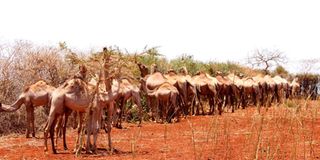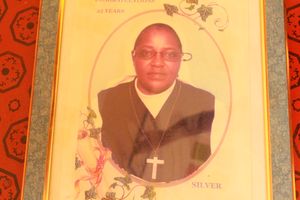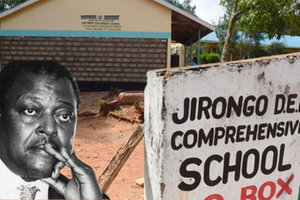Premium
Herders move to protected areas and farmlands as drought bites

Camels feed on euphorbia in Lachathuriu, Tigania West in Meru. For cattle herders in Meru, getting pasture for their cattle is now a matter of life and death as drought continues to push them further into farms and protected areas.
For cattle herders in Meru, getting pasture for their cattle is now a matter of life and death as drought continues to push them further into farms and protected areas.
Early last month, four people were injured in Ntukai, Igembe Central, when they were attacked by herders who had defiantly invaded private farms.
In the last two months, the conflict between herders and crop farmers has intensified in Igembe North and Igembe Central.
Pastures in the northern Meru region where pastoralism is still practised have been depleted, prompting herders to migrate to other areas.
Ndumuru herders chairman Genesio Gitonga said they had covered more than 50km in search of pasture.
Crop leftovers
“We are now desperately looking for farms where there are crop leftovers. Thousands of cattle have relocated to Kinanduba but this cannot sustain the animals. We have been barred from accessing Meru National Park, where there is grass,” Mr Gitonga said.
Mr Charles Kamwibua, a herder, said the national government, through drought intervention programmes, had promised to support them but no feeds were forthcoming.
Members were now leasing farms to sustain their animals, said Igembe Central Herders Cooperative chairman Francis Kaberia.
“We are now praying that our animals survive the remaining four months of drought. It will be very expensive to survive the next four months before the rains in October. The government should come to our aid by providing animal feeds," Mr Kaberia said.
Lease farms
Without access to Meru National Park, he said, herders must lease farms in Igembe Central and Igembe South for their herds.
Meru Livestock Chief Officer David Mugambi said the county is overstocked, amplifying the effects of drought.
"Most of the herders have relocated their animals to the Imenti forest as well as towards Tharaka North. However, those who were grazing in the forest are moving out due to unfavourable conditions. The big challenge is that the number of cattle is double the capacity that our grazing lands can handle," Dr Mugambi said.
According to the 2019 national census, there were more than 170,000 indigenous cattle in Meru County, a majority of them in northern Meru.
Indigenous cattle
Dr Mugambi said the population of indigenous cattle now stands at slightly above 200,000, with the same number of dairy herds.
He added that pasturelands in northern Meru that cover about 64,000km square have been overgrazed.
"Based on the condition of the pastureland, one cow requires 15 acres. This is because grass has been depleted by years of overgrazing," the veterinarian said.
He said the county government had established beef cooperatives and a union in the northern region to support herders in improving livestock keeping.
Part of the plan, he said, is to improve local breeds and train herders on how to rear beef animals for the market.




